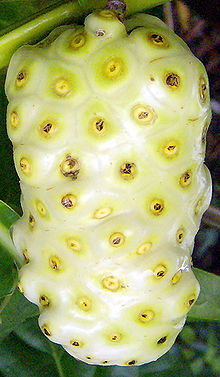Morinda citrifolia is a fruit-bearing tree in the coffee family, Rubiaceae, native to Southeast Asia and Australasia, and was spread across the Pacific by Polynesian sailors.[1] The species is now cultivated throughout the tropics and widely naturalized.[2] There are over 100 names for this fruit across different regions. Common English names include great morinda, Indian mulberry, noni, beach mulberry, vomit fruit, awl tree, and cheese fruit.[3]
| Morinda citrifolia | |
|---|---|
 | |
| Leaves and noni fruit | |
| Scientific classification | |
| Kingdom: | Plantae |
| Clade: | Tracheophytes |
| Clade: | Angiosperms |
| Clade: | Eudicots |
| Clade: | Asterids |
| Order: | Gentianales |
| Family: | Rubiaceae |
| Genus: | Morinda |
| Species: | M. citrifolia |
| Binomial name | |
| Morinda citrifolia | |
The pungent odor of the fresh fruit has made it a famine food in most regions, but it remains a staple food among some cultures and is used in traditional medicine. In the consumer market, dietary supplements are sold in various formats, such as capsules and juices.

Growing habitats
Morinda citrifolia grows in shady forests and on open rocky or sandy shores.[4] It takes 18 months for the plant to mature, and yields 4 and 8 kg (8.8 and 17.6 lb) of fruit per month throughout the year. It is tolerant of saline soils, drought conditions, and secondary soils. It can be found in various environments including volcanic terrains, lava-strewn coasts, and clearings or limestone outcrops, as well as in coral atolls.[4] It can grow up to 9 m (30 ft) tall and has large, simple, dark green, shiny, and deeply veined leaves.
The plant bears flowers and fruits all year round. The fruit is a collective of multiple fleshy fruits that emit a pungent odor while ripening. It is commonly cited as "cheese fruit" or "vomit fruit". It is oval in shape and reaches 10–18 centimetres (3.9–7.1 in) in size. At first green, the fruit turns yellow, then almost white as it ripens. It contains many seeds.[4]
Morinda citrifolia is attractive to weaver ants, which make their nests by using the leaves of this tree.[4] These ants protect the plant from some plant-parasitic insects. The smell of the fruit also attracts fruit bats, which aid in dispersing the seeds. A type of fruit fly, Drosophila sechellia, feeds exclusively on these fruits.[5]
Uses

A variety of beverages (juice drinks), powders (from dried ripe or unripe fruits), cosmetic products (lotions, soaps), oil (from seeds), and leaf powders (for encapsulation or pills) have been introduced into the consumer market.[6]
Culinary
Indigenous peoples used the Noni fruit as emergency food during the famine.[6] Therefore, it is also called "starvation fruit". Despite its strong smell and bitter taste, the fruit was nevertheless eaten as a famine food,[7] and, in some Pacific Islands, even as a staple food, either raw or cooked.[8] Southeast Asians and Aboriginal Australians consume fresh fruit with salt or cook it with curry.[9] The seeds are edible when roasted. In Thai cuisine, the leaves known as bai-yo are used as a green vegetable and are the main ingredient of Kaeng bai-yo, cooked with coconut milk. The fruit luk-yo is added as a salad ingredient to some versions of Som tam.
In Cambodia, noni leaves are an essential part of the national dish amok.[10]
Traditional medicine
Green fruit, leaves, and root or rhizomes might have been used in Polynesian cultures as a general tonic, in addition to its traditional place in Polynesian culture as a famine food.[6] Although Morinda is considered to have biological properties in traditional medicine, there is no confirmed evidence of clinical efficacy for any intended use.[11] In 2018, a Hawaiian manufacturer of noni food and skincare products was issued an FDA warning letter for marketing unapproved drugs and making false health claims in violation of the US Food, Drug, and Cosmetic Act.[12]
Dyes
Noni fruit has traditionally been used by Austronesian peoples mainly for producing dyes. It was carried into the Pacific Islands as canoe plants by Austronesian voyagers. Morinda bark produces a brownish-purplish dye that may be used for making batik. In Hawaii, yellowish dye is extracted from its roots to dye cloth.[13][14] Yolngu artists at Bula'Bula Arts in Ramingining, in central Arnhem Land in the Northern Territory of Australia, use the roots and bark of "djundom," as it is known to them, to dye the fibres of pandanus to create a wide variety of artifacts.[15]
The use of M. citrifolia as a fabric dye, and applying a mordant to the fabric before dyeing is necessary. This process can be labor-intensive if the goal is to achieve shades and hues with the morinda dye.[16]
Popular culture
The fruit is widely used in eating challenges in the British reality television program I'm a Celebrity...Get Me Out of Here! where it is referred to as "vomit fruit."[17]
Nutrients and phytochemicals
Morinda citrifolia fruit powder contains carbohydrates and dietary fibre in moderate amounts.[18] These macronutrients reside in the fruit pulp, as M. citrifolia juice has sparse nutrient content.[19] The main micronutrients of M. citrifolia pulp powder include vitamin C, niacin (vitamin B3), iron, and potassium.[18] Vitamin A, calcium, and sodium are present in moderate amounts. Compared to powdered pulp, only vitamin C is retained in the analysis of M. citrifolia juice.[19] The juice contains 34 mg of vitamin C per 100 g, which is 64% of the amount found in a raw navel orange (53 mg per 100 g of orange, or 89% of the Daily Value).[20] Sodium levels in M. citrifolia juice (about 3% of Dietary Reference Intake, DRI)[18] are high compared to an orange, while potassium content is moderate.[20]
Morinda citrifolia fruit contains several phytochemicals, including lignans, oligo- and polysaccharides, flavonoids, iridoids such as deacetylasperulosidic acid,[21] fatty acids, scopoletin, catechin, beta-sitosterol, damnacanthal, and alkaloids.[22]
Gallery
- M. citrifolia flower
- Young noni growing on Oahu, Hawaii.
See also
References
External links


